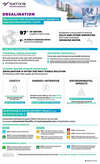Could scaling up desalination solve global water challenges?
Desalination currently accounts for only 1% of world’s drinking water supply although almost 97% of global water available on earth is salty. Should we aim at scaling up desalination to solve global water challenges? The answer is mixed. The use of desalination technologies only makes sense under very specific circumstances.
Desalination is an energy-intensive and costly way to obtain drinking water, and entails negative environmental impacts, even if the technology is developing to reduce these shortcomings. However, it is often the only viable solution for achieving a safe water supply in water-scarce countries. This makes a strong case for the socioeconomic benefits of desalination.
This paves the way for financing desalination assets with either “social” or “sustainable” financial instruments. The Sustainable Development Goals (SDGs) framework can be used to assess both the positive and negative impacts of desalination assets.
DESALINATION: BALANCING THE SOCIOECONOMIC BENEFITS AND ENVIRONMENTAL COSTS

LISTEN TO THIS Q&A FEATURING RADEK JAN AND IVAN PAVLOVIC, INFRASTRUCTURE AND GREEN & SUSTAINABLE ANALYSTS AT NATIXIS

